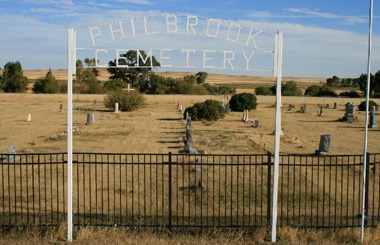
Welcome to the Philbrook, Montana Picture Tour
While you looking at the “What the Hay” sculptures & Cory Holmes’ “Fence Post Art” along state road 239 take a minute and pay a visit to Philbrook, Montana. Philbrook is where the stage & freight wagons crossed the Judith River on their way west to Great Falls & Fort Benton.
The last stage stopped in Philbrook in 1909 but you can still see the red livery stable where teams of horses were kept. On the opposite side of the road is a vacant white building, that’s the old Philbrook Post Office. Notice the arched window on the second floor? You can see the same “Italianate” style (1850-1880) windows in the beautiful nearby houses and the St Mathias Church in Moore, Montana.
Standing on the bridge looking west you can easily image stage & freight wagons crossing the Judith River. Before we leave let’s ride over to the picturesque Philbrook Cemetery.
The Philbrook Historical Marker Reads: 1881 Philbrook 1909
“March 14, 1881 A man named Claggs squatted here on a ¼ section and built a house, a saloon and put in a stock of goods. In the winter of1881 E.J. Marrison who had bought out Cloggs established a Post Office and named it Philbrook after his mother’s maiden name.
Philbrook grew to two hotels, two stores, a saloon, two blacksmith shops, a doctors office, a Presbyterian church and a community hall. Two stages a day came from Great Falls to Lewistown crossing the river here. All freight from Fort Benton to Musselshell country crossed the river here. Brother Van Orsdel came from Great Falls (83 miles) and Rev. George Edwards came from White Sulphur Springs (117 miles) to provide services every two weeks.
Charlie Russell had had his horse shod at the blacksmith shop. The Great Northern Railroad came to Hobson in 1908 so the Post Office moved to Hobson, January 1, 1909 the train carried the to Hobson for the first time and it was two days late.
The last stage stopped at Philbrook January 31, 1909. The (red) barn on the east side of the road was once the big livery stable. The building just west of the road and south of the bridge was built by Tim and Dick Jellison as a carpenter shop which later served as a store and Post Office.”

